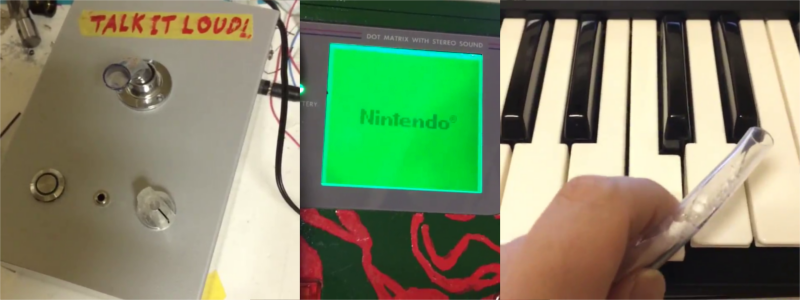Have you ever listened to a song and wondered how they created the robotic-sounding vocals? There’s a huge variety of ways to do so. [scythe1005] decided to take their inspiration from rock history, creating a Game Boy powered talkbox (Japanese, Google Translate recommended for those that don’t speak the language).
Human speech is generated when vibrations from the vocal chords are shaped into intelligible sounds by the motion of the mouth, tongue, and other body parts known as “articulators”. A talkbox creates robotic speech sounds by using the articulators while replacing the vibrations from the vocal chords with alternative source.
A talkbox is a device most typically used with the electric guitar. The signal from the electric guitar is amplified and played through a speaker or transducer connected to a tube that is placed in the user’s mouth. The user then proceeds to mouth the desired words they wish to say, with the vibrations provided by the guitar’s signal instead of the vocal chords. A popular example of this is Peter Frampton’s use of the talkbox in Do You Feel Like We Do.
[scythe1005] used the same basic bones in their design, using a Game Boy to feed sound into a basic audio amplifier kit and a transducer connected to a tube. This gives a very 1980s synth sound to the vocals. It’s a simple build in concept but one we haven’t seen a whole lot of before. Using off-the-shelf modules, you could build something similar in a weekend. Also featured in the video is an ArduinoBoy — a useful way of controlling a Game Boy over MIDI. It’s used here to interface the keyboard to the handheld console. Video below the break.
As we’ve seen before, the Game Boy is an incredibly popular platform for music — chiptune artists regularly modify the device for better sound.















Title of the year nominee.
You are too kind!
For anyone interested, I sell a cheap arduinoboy kit at catskullelectronics.com
Keep in mind that in addition to an arduinoboy, you need a flash cart to run the synth program on the Gameboy. I have an entry level cart that will run the program for only $10!
I use my Gameboy as a serial terminal (actually an SPI terminal) with a simple DIY flashcart. It consists of just a flash chip and some latches for the upper address lines (unfortunately it’s not compatible with MBC1 but it’s much simpler). And I can program it right from the gameboy using its SPI link port and a small bootloader in the cart. It’s terribly slow, but it works. For sending data to the link port I use an ESP8266 with its hardware SPI port.
I even made a simple text-only browser with that ESP8266. It runs on Espruino so it supports some basic javascript too (AJAX and simple DOM manipulation). I’ll share it because it’s one of the first ESP8266 browsers to support JS (probably the first).
I planned to make an emulated cart using an STM32 (like Dhole’s prototype and Sprite_tm’s Vectrex cart) but I never worked on it. It would have the advantages of easy ROM transfer, compatibility with all MBCs, GPIO and extra features (ARM coprocessor, extended storage, even audio playback with a faster CPU and the Gameboy’s sound input pin), but it turned out to be a nightmare to code, with very critical timings.
>”to support JS (probably the first).”
hey, Hey, HEY! Don’t make it sound like super epic. tessel.io still around. espruino.com as well. Oh. OH. You mean specific to ESP8266. Got it. However I have to admit I still awaiting a Arm-64 bit that supports OpenCL version 2.x or better.